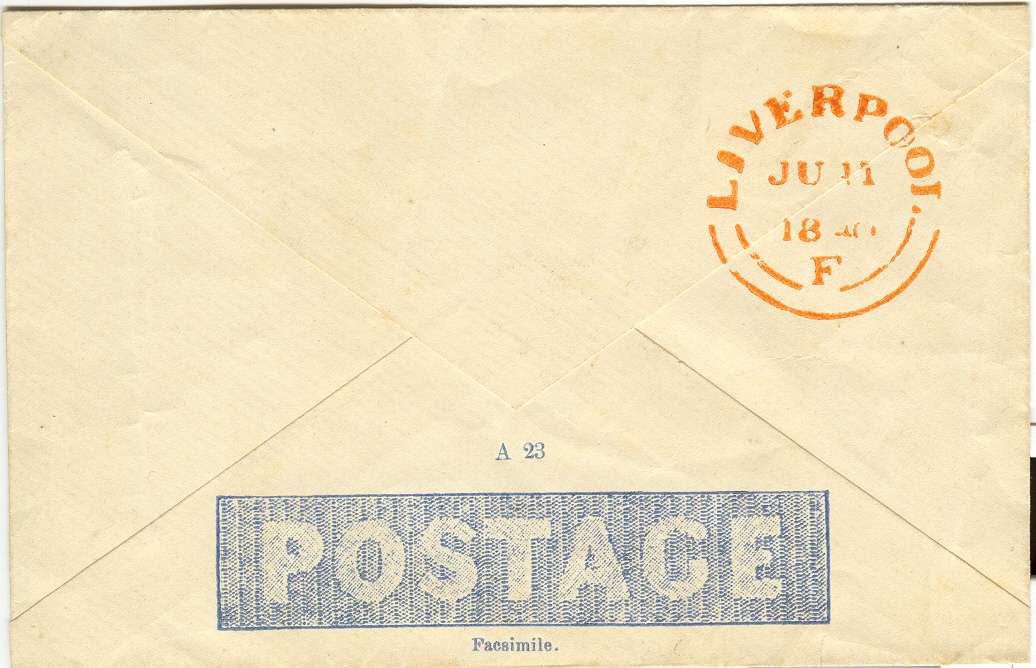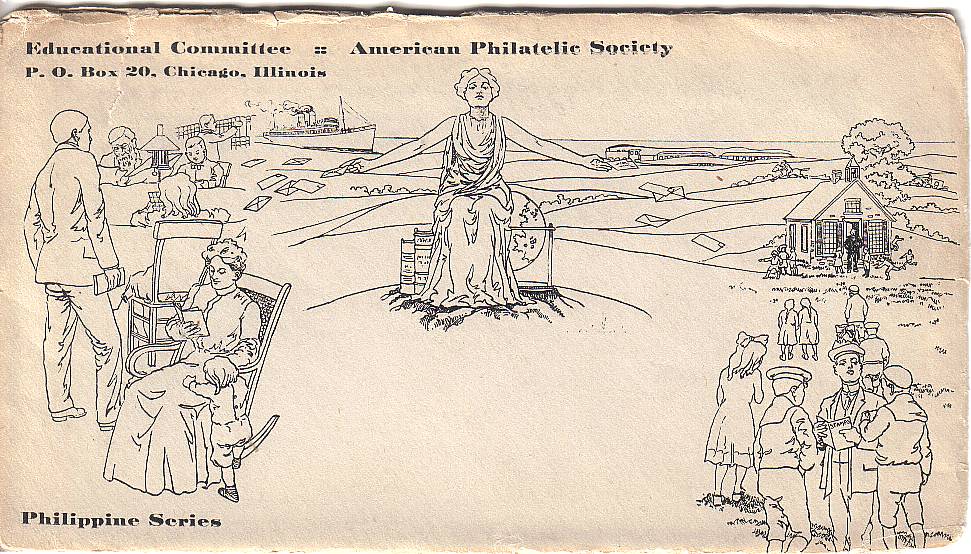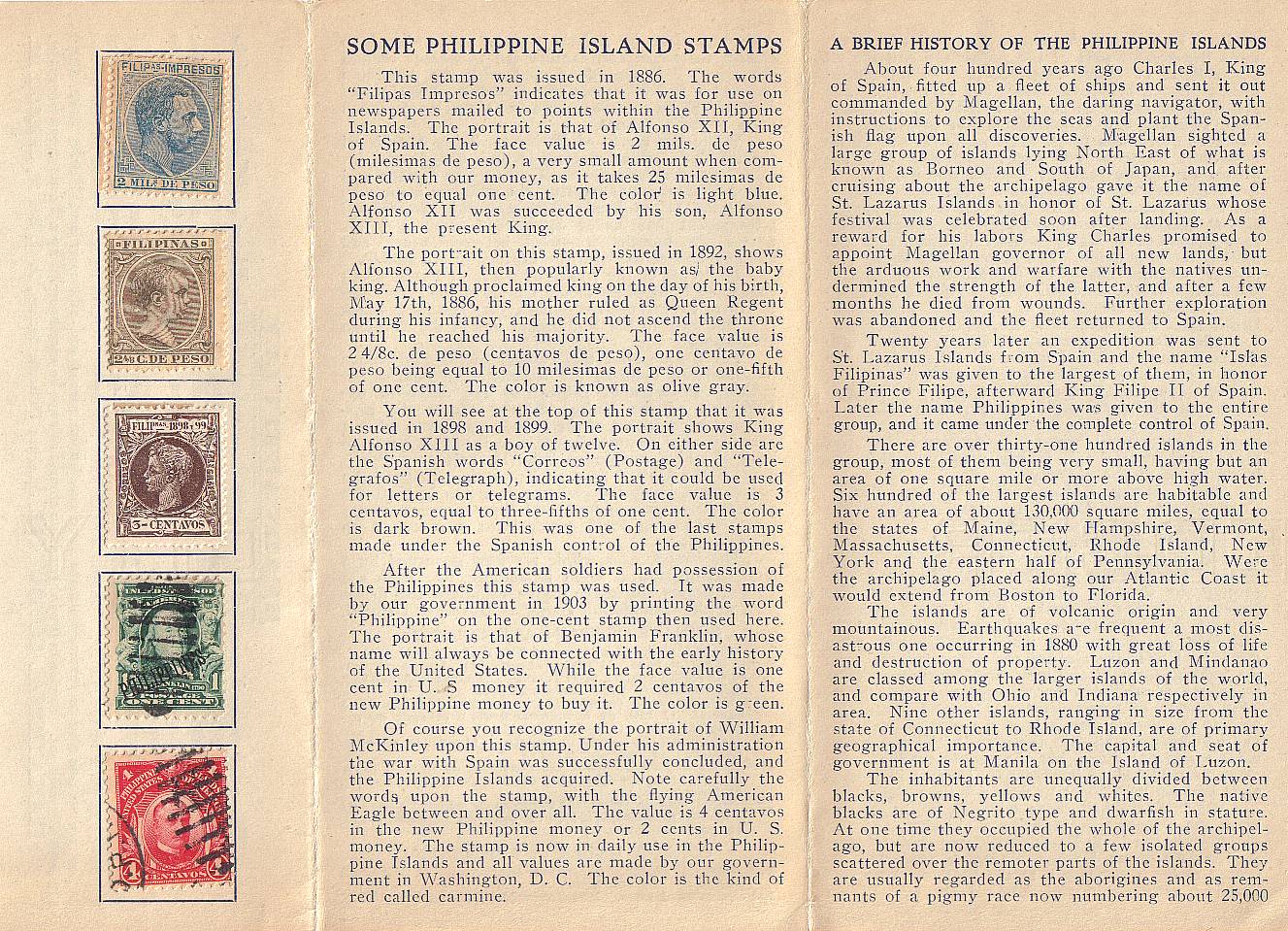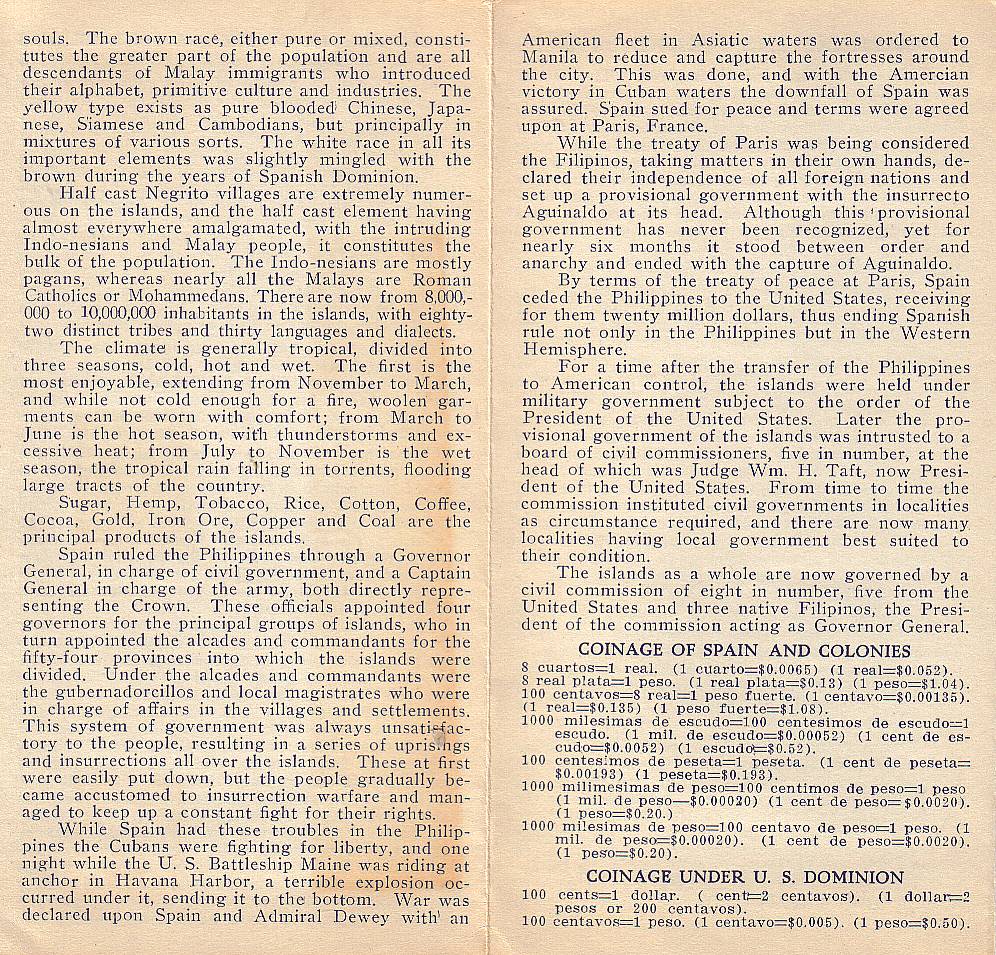M is for Mulready Envelopes - Page 2 |

|

|

|

|
Illustrated Envelopes
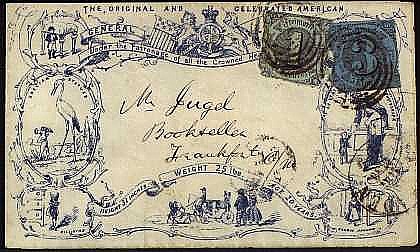
Fortunately, even the withdrawal of the Mulreadys, and the end of the direct parodies,
did not end the development of the concept. Envelopes became standard vehicles for
political parodies, and people came to like the idea of some sort of decoration or
message on their envelopes, leading to many other sorts of designs with clear roots in
the Mulreadys, but no intent of parodying their design.
British Propaganda Envelopes
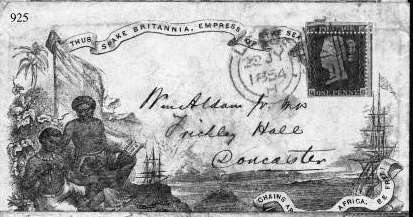
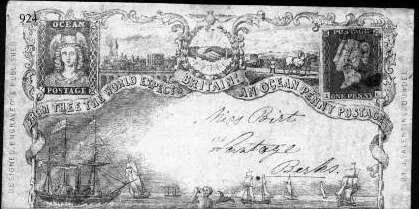
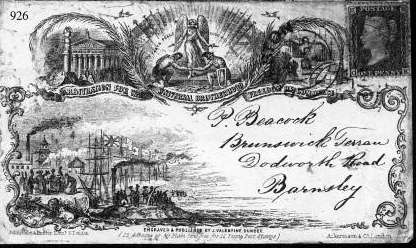
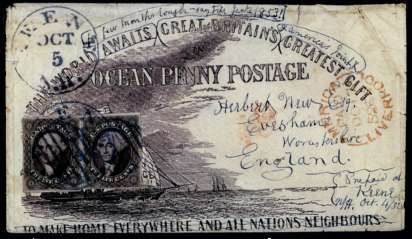
Like
the patriotic envelopes of the 1860's in the US,
British Propaganda envelopes gave
people a means of expressing national pride, or of campaigning for a favorite cause.
These included promotions for Ocean Penny Postage (later called Imperial Penny Postage,
i.e. the extension of Island Penny Postage to include the entire British Empire); anti-
slavery appeals; temperance (anti-liquor) propaganda; and exhortations for Peace and
Universal Brotherhood.
Hand-Painted Envelopes

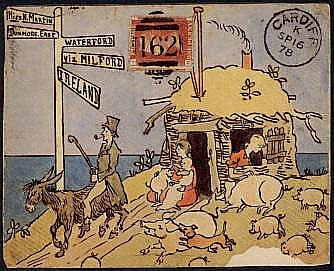
By the end of the 19th century people were creating beautiful one-of-a-kind, hand-
decorated artworks like the ones above on their envelopes. Interestingly, these seem to
have been a primarily British phenomenon - I have seen no similar examples originating in
the US, but many from Great Britain and the British Empire.
Reproductions and Forgeries
The Mulready envelope and letter sheet have been reproduced many times in the 160-odd years since their creation, both in tribute and to defraud. A very nice reproduction was issued officially as part of the 150th birthday celebration of the Penny Black in 1990, and it, like other honest reproductions, carries a clear notation saying that it is a reproduction. Once can buy those 1990 reproductions for $10 or so, and they make a nice substitute for the real thing, since the price of a clean mint copy is about $150 these days, while a nice used one will cost you at least $200. Those prices make it well worth the efforts of a counterfeiter to create and sell fakes, though, so as always with high-priced philatelic material, caveat emptor is good advice when you buy one.
Which leads to the item shown above. A reader of this page sent me those scans on April 11, 2003, saying "Some years ago my wife got from her Grandfather a Mulready cover", and asking if I could tell him who was John Thompson (whose name is printed in the bottom, right corner of the design). I explained that John Thompson was the engraver, and added that information up at the top of this page. The inquirer also asked if I could tell him anything about his cover, and ordinarily I would have said "No, but I'll consult an expert." However, I took a minute to enlarge the images and look at them more closely. On the back one can read the word "Facsimile" at the bottom, and the mystery was solved. This is another reproduction. That still leaves the question of when and why this was produced. Can anyone shed light on that?
April 16, 2003 - I consulted a Mulready expert about this reproduction, and he had the following observations to add:
Can't tell you the origin of this particular facsimile Mulready. But, interestingly the "reproducer" even got the stereo number (on reverse of all Mureadys) wrong. This example has stereo number "A23". There was no such stereo number for genuine TWOPENCE Mulreadys - only on ONE PENNY. And the TWOPENCE ones had a small "a" whilst the ONEPENNY had capital "A".
Well, at least the creator did have the courtesy to mark his creation "Facsimile."
LATER - the reader who sent the cover added this:
The name on the cover is a stamp collector shop in Amsterdam which no longer exists. The handwriting shows that it is old. The address is now a coffee shop www.coffeeshop.freeuk.com where you can get soft drugs. Obviously this brings more profit than the stamps.
If I look along the paper I see relief. So it is not a plain copy but it is printed. I assume they used the same printplate for it. Does the printer firm still exist or who has the rights for the printing plates? Maybe they can tell when this reproduction was made.
I consulted my expert (see the exhibit pages, above), who replied that the original plates were destroyed long ago, so all reproductions have been made from new plates. Moreover, if one compares this reproduction with an authentic copy there are many obvious differences.
The most obvious is the text "POSTAGE TWO PENCE" at the bottom of the front, which is in an entirely different typeface from the real thing.
Homage to the Mulreadys

The Mulready envelope has been reproduced in many forms to pay homage to its place as
the first of its kind. The stamp above is one of my favorite of these reproductions, a
poster stamp issued to advertise a philatelic exhibition in London in 1897. And below
are a few more modern reproductions of the Mulready, mostly by stamp dealers.(click on
any of these images for a hi-res version)
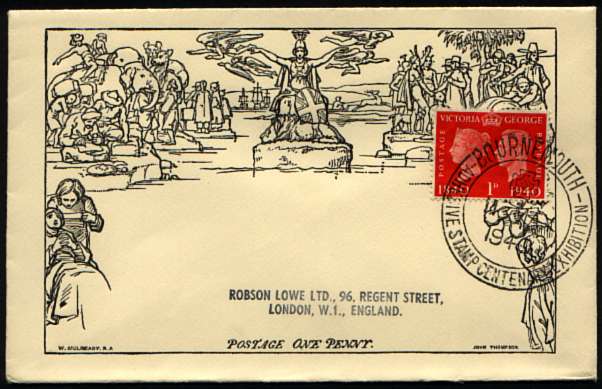
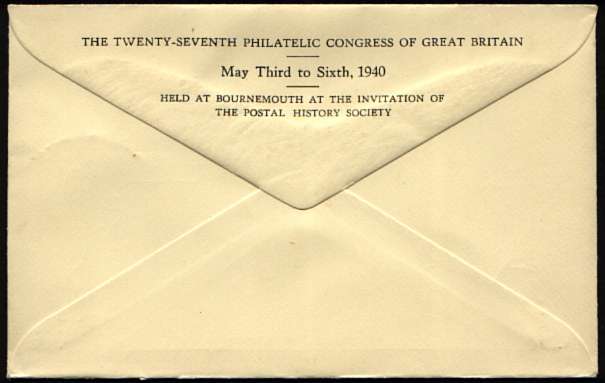
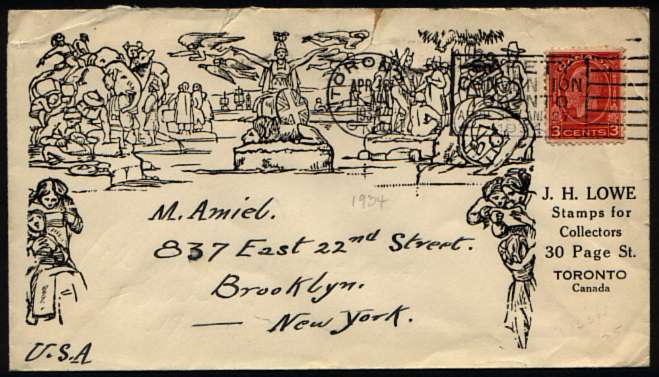
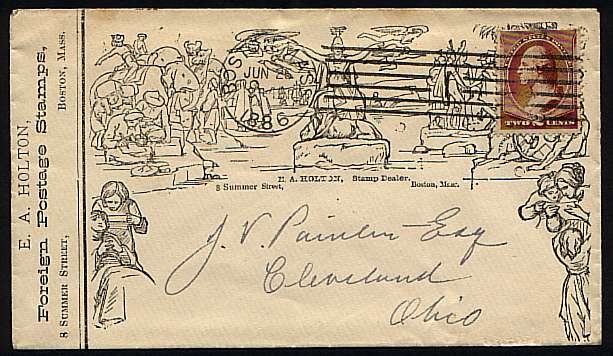

The last item above, a First Day Cover for the stamp issued to commemorate the
centennial of the Statue of Liberty, was produced by Julian and Sharon Pugh, who are
another of my favorite FDC makers - in addition to their beautiful designs, they enhance
their covers with enclosures that discuss the historical and philatelic significance of
the stamp and their cachet. In this case, while they discuss ably the Statue of Liberty
and the Mulready envelopes, they do not explain why they put the two together. Still, a
very attractive item.
6/30/2004 - I finally got curious enough about Julian Pugh's design above that I simply emailed him and asked - What's the connection? I theorized he might have been implying a similarity between the figure of Britannia and Lady Liberty. He replied:
We did a total of four different cachet designs for that issue. See color Plate 19 at our website [www.julianpugh.com] at Grid B6, C6, D6, and B7. It is very unusual that we do that many different designs for a single issue, but as, you know, this was a JOINT issue and one of our buyers [I do not remember just who] specifically asked me to use the Mulready envelope as the basis of one of the joint issues that had both the French and USA cancel so I did. There was no other reason. We were just glad to accommodate a subscriber.
Thanks, Julian. And as he implies there, his web site now includes images of ALL his FDCs, so it's worth
a visit for that alone.
(8/11/2019 - Sadly, that web site is now defunct - I wish I had archived a copy!)
Below is a new favorite of mine, an envelope produced by the American Philatelic Society around 1912, as part of an educational program intended to interest young people in stamp collecting. I think it echoes admirably the spirit of the original - Oh, look, there's even a train!
4/13/2008 - Collector John R. Hedley, a visitor to my site, wrote to tell me that he possesses a copy of the envelope above, complete with its original contents! He sent scans, shown below. The statement that Taft is President confirms the date as around 1912, and the date on the pink envelope pins it down to 1910.
I had not paid attention to the text on my envelope, so didn't think to wonder whether, if there was a Philippine Series, there might be other series. The text of the enclosures tells us there were two others, for China and Australia. Can anyone provide scans of those? Were there more?
| Home | M - Page 1 <<< | Contents | >>> N is for Numerals | Credits |
All Letter images Copyright © 1997, 2000, SF chapter of AIGA
All text Copyright © 2000, William M. Senkus
Send feedback to the author: CLICK HERE
Revised -- 04/20/2008

